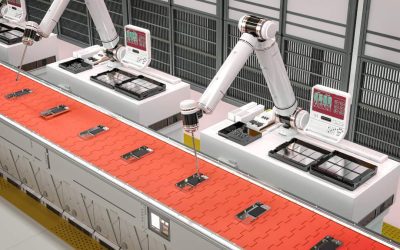As we head into the second half of 2023, it’s pleasing to read reports and see first-hand, that the fast pace and ongoing growth that the manufacturing sector is experiencing will continue, despite ongoing supply issues, labour shortages, and economic uncertainty.
However, this is only if manufacturers continue to capitalise on opportunities and look to invest and innovate in the right technologies to support more agile operations.
In this post we look at what the manufacturing sector is doing so well. How is it continuing to build on the momentum from the pandemic, how the need to innovate is ever-growing, and what other trends we need to be aware of as we head into the second half of 2023.
Ongoing Industry Trends
Demand and production capacity hit staggering highs – during the pandemic, the need for manufacturing services increased dramatically, and this crest of the wave has continued well into 2023. Manufacturers are now showing their range of ability and, in some instances, agility when faced with global logistics backlogs and a shortage of materials. Greater supply chain resilience has been created, and risks mitigated with the introduction of digital technology and manufacturers looking to build local capacity.
Overinflation and economic uncertainty – ongoing issues such as the war between Russia and Ukraine, recession, inflation, Brexit, tensions between the West and China, international sanctions, and even extreme weather conditions have all impacted the movement of goods and production lines. Re-shoring and bringing production closer to the shop floor has played a significant role in allowing manufacturers to look at alternative solutions.
Ongoing labour issues – there is currently a global phenomenon with skills shortages and high churn in the manufacturing sector. People are now looking for better wages, better working conditions, and, as we move post-pandemic, a better work-life balance. What we’re facing in the manufacturing sector is a big exodus of skilled labour as most employees are 55 or older. From the beginning of 2023, the focus has been to attract, hire, and retain younger talent. Offering more competitive pay and benefits, better working conditions, and flexibility.
Investment in tech – increasingly, manufacturers are investing heavily in technology to build greater resilience and agility. Capitalising on technological innovations and adopting emerging tech to help mitigate risk, manage employee safety, and reduce costs. Techs such as remote monitoring, servicing, and equipment operation so you no longer have to be on-site are just some of the innovations that manufacturing is capitalising on. Meeting increased demand with a decreased labour force; technology is bridging the skills gap and increasing efficiency.
Upcoming Trends
Cost issues – with ongoing economic uncertainty and inflation showing no signs of slowing down, costing pressures will continue into 2023 and beyond. Manufacturers must look for more feasible supply chain solutions, one of which is reshoring. The opportunity to reshore is gaining momentum as doing business closer to home bolsters continuity.
Retain and train top talent – this is an emerging trend as we head into the second half of 2023, as manufacturers accept that despite a record high of new hires, there is still substantial workforce churn. Churn that is reducing operational efficiency and margins. To capitalise on this trend and create a more positive outlook, manufacturers are creating better working conditions, focusing on workplace wellness, flexible working patterns, providing greater transparency, and more. Automation will be key to help capitalise on this trend and support in this area, driving growth in demand for skilled workers who can operate and manage such technology. In order to innovate, manufacturers need to look at upskilling workers and creating an environment that promotes a healthy workplace.
Creation of smart factories – the future of manufacturing will focus on creating smart factories. Driving future competitiveness through integrating automation with existing infrastructure to allow you to make informed, strategic decisions using real-time data, smart factories will largely be driven by technological advances to improve business agility and worker safety.
Working toward a smart factory allows you to reduce operating costs, enhance process efficiency, improve safety, increase product innovation, and reduce the need for employees to spend so much of their time on repetitive tasks.
Smart factories will mean implementing connected machinery and equipment that offer you optimum process efficiency. Downtime can be minimised by predictive maintenance, parts for repairs can be automatically dispatched, technology such as computer vision can monitor quality controls and fine-tune results where necessary, and you can achieve a reduction in waste and emissions through the monitoring and control of energy consumption, and with the introduction of Digital twinning, digital simulations of systems can be created in the virtual world allowing you to measure, analyse and experiment much more efficiently and cost-effectively. From this digital twinning process, the final simulation that works can then be recreated in the real world.
Sustainability is more than a keyword – everyone will be keeping an extremely close eye on environmental, social, and governance changes throughout the remaining months of 2023, as sustainable business solutions are now no longer a nice to have but very much a must-have and manufacturers will need to comply and make operational changes as a result. For example, we will see an increase in pressure placed on businesses to switch to renewable energy sources, a greater focus on net zero emissions, and the ability to provide full traceability across all product components will be vital features as we move forward into the year.
Innovate your manufacturing by capitalising on current industry trends
The focus for 2023 is the need to leverage digital technologies to drive supply chain resilience.
Automation is what will drive these changes and push people to innovate.
Not a new concept but one where companies are investing in more than ever to drive efficiencies, reduce waste, and combat fraud across supply chains.
Those manufacturers who are agile, who can navigate these challenges and leverage opportunities, are those who will reap considerable gains.
Experienced in designing, developing, and producing innovative purpose-built automation machines for the manufacturing industry, for automation solutions that bring success, speak to a member of the Innomech team today.




